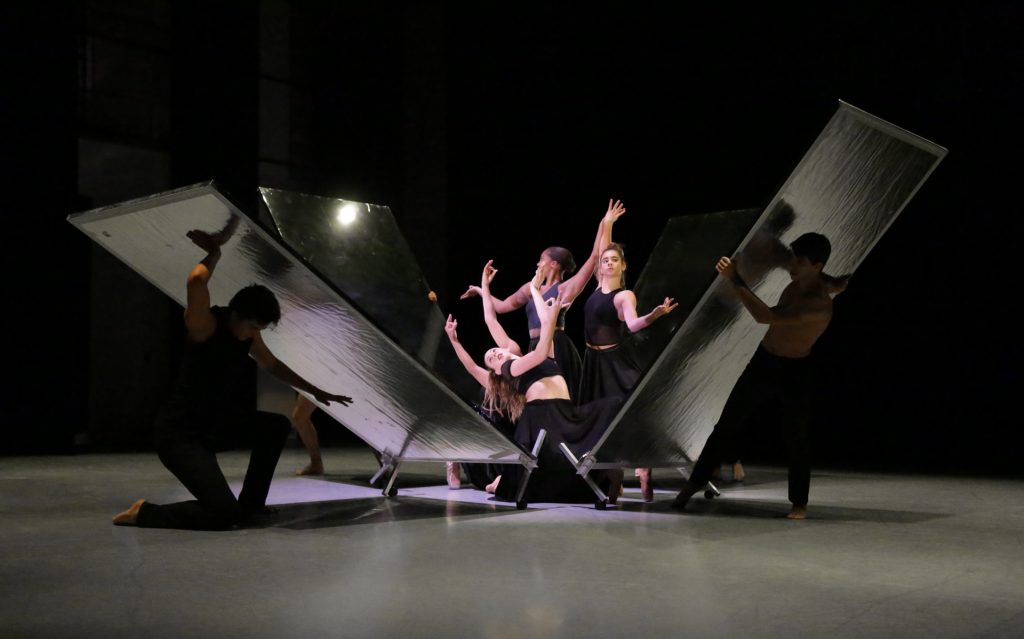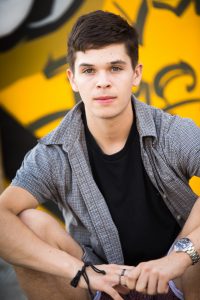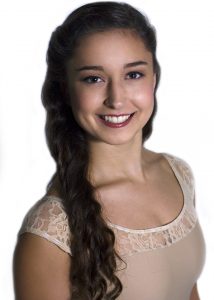Admissions Q&A: Student Choreography at USC Kaufman
November 2, 2018

BFA students perform in the annual Student Choreography Showcase | Photo by Mary Mallaney
Through courses such as Improvisation and Composition, USC Glorya Kaufman School of Dance BFA students have numerous opportunities to choreograph and present their work in various settings: from studio showings to full-scale shows in our large performance space.
We checked in with sophomore Aurora Vaughan and junior Brendan Evans to learn about what they are working on and what it is like to be a choreographer here at USC Kaufman.
How has being at USC Kaufman changed your choreography?
Brendan: Studying [William] Forsythe technologies completely changed the way I approach choreography. It led me to be more inquisitive, analytical and geometric in my approach to creating movement. I love seeing all the unique ways my classmates use Forsythe’s ideas. Additionally, being exposed to such a wide variety of techniques has allowed me to pull from different skill sets during the creative process.
Aurora: When I first came to USC Kaufman, the only experience I had with choreography had been creating little phrases at my home studio in the Bay Area. Learning Forsythe’s technologies opened up a new lens through which I could explore space and the body’s relationship to it. The technologies were (and are) still challenging to use, but they allow for some amazing creations. Also, my classmates all have brilliant artistic minds, and watching or working with them helps generate and perfect ideas. They are always open to talking through concepts with me, and having them as a sounding board has been helpful.
What is the most challenging part of choreographing?
Brendan: I find it challenging to break my usual patterns of movement, so in the duet I’m working on now, I’m trying to continually do something out of my comfort zone. I am creating a duet with two females to stretch my boundaries, seeing that I don’t know what it’s like to move as a female body. I think challenging parts of choreography can sometimes be the most fun. You are forced to problem solve in real time.
Aurora: The most challenging aspect of choreography for me is self-criticism. I tend to be doubtful of my abilities as I go through the choreographic process, which can be detrimental to the progression of the piece if I let it get out of hand. By trying to work through these doubts, I’ve realized that I prefer choreographing on paper before I process it physically, which is informative as an artist and can help the dancer(s) see my vision before we start moving together.
What is your favorite part of choreographing?
Brendan: I think the best part is being in the studio with my peers. Everyone is serious and focused, but we also let ourselves have fun. Being able to share the space with dancers like Alyssa Allen and Jessica Muszynski is only increasing my respect and love for them as dancers, collaborators and people. My other favorite part is having such a beautiful space to work in. Right now, as college students, we have time and we have free space. Sometimes you don’t have this in the real world.
Aurora: My favorite part of choreographing is seeing how the same movement looks different on different bodies. I’m currently choreographing on someone about a foot taller than me. Through this process, I’ve found that things that work for me do not always work for them. Finding the balance between keeping the same intention and making sure the dancer is comfortable is sometimes tricky. But, it’s fun to figure out. The finished product is usually even better than what I originally intended it to be.
What are you working on right now?
Brendan: I am currently working on a duet with seniors Jessica and Alyssa. I am also collaborating with Sophie Mathieu, a composer in the USC Thornton School of Music. She is deconstructing a Bach Cello Suite and making it an electronic score for my piece. In the choreographic process, I am focusing on use of space and development of character. These are two elements we have been working on a lot in composition classes.
Aurora: Currently, I’m working on the expansion of a solo piece for my sophomore Improvisation & Composition class. It follows a personal story, and working on it has been such a pleasure. Writing all of my ideas out before beginning movement was how I came up with the choreography; I started with phrases or images, and tried to see how they would translate onto a body. When I first started choreographing it, I wasn’t sure what my vision was. As the pieces came together with my dancer, I realized that it was there the whole time.
Aurora, Brendan and many more Kaufman choreographers are presenting work soon. Be sure to check our website and social media for all of the latest information.

